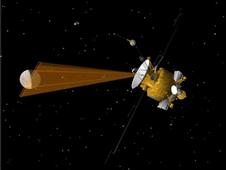| Image | Name | Short Description | Launch Date | Target | Acronym | Destination | Summary | Keywords |
|---|---|---|---|---|---|---|---|---|
 |
Deformation, Ecosystem Structure and Dynamics of Ice | A proposed Earth satellite mission with the potential to identify likely earthquakes, volcanos and landslides, the Deformation, Ecosystem Structure and Dynamics of Ice, or DESDynI, mission will use specialized sensors to study land surface and climate changes. | 2019 | Earth | DESDynI | A proposed Earth satellite mission with the potential to identify likely earthquakes, volcanos and landslides, the Deformation, Ecosystem Structure and Dynamics of Ice, or DESDynI, mission will use specialized sensors to study land surface and climate changes.
Because of its numerous potential science applications, the mission, originally slated for launch between 2010 and 2013, is under review to determine its best course of study. |
severe weather, natural disasters, earthquakes, volcanoes, tornados, wildfires, hurricanes, space missions, NASA missions, Earth satellite, climate change, JPL, NASA, NASAJPL | |
 |
Mars Sample Return | Mars Sample Return is a proposed mission to return samples from the surface of Mars to Earth. | To be determined | Mars | MSR | Mars | Mars Sample Return is a proposed mission to return samples from the surface of Mars to Earth. The mission would use robotic systems and a Mars ascent rocket to collect and send samples of Martian rocks, soils and atmosphere to Earth for detailed chemical and physical analysis. | Mars, Mars mission, mission to Mars, Mars Sample Return, geological sample, Mars proposed mission, Martian, Martian rocks, JPL, NASA, NASAJPL |
 |
Single Aperture Far-Infrared Observatory | The Single Aperture Far-Infrared Observatory, or SAFIR, is a proposed NASA mission to study the earliest evolution of galaxies, stars and planetary systems using a large cryogenic space telescope. | 2015 | Universe | SAFIR | The Single Aperture Far-Infrared Observatory, or SAFIR, is a proposed NASA mission to study the earliest evolution of galaxies, stars and planetary systems using a large cryogenic space telescope.
Designed as a follow-on to the Spitzer Space Telescope, the mission would use a single primary mirror more than five times the size of Spitzer's to detect and study objects previously masked by dust and other space debris. |
Universe, galaxies, formation of the universe, stars, star birth, planets, how the planets formed, space telescope, outer space, SAFIR, Single Aperture Far-Infrared Observatory, JPL, NASA, NASAJPL | |
 |
Inertial Stellar Compass | A brainchild of the Space Technology 6 project, the Inertial Stellar Compass is a conceptual advanced navigation system designed to allow spacecraft of the future to operate more autonomously. | To be determined | To be determined | A brainchild of the Space Technology 6 project, the Inertial Stellar Compass is a conceptual advanced navigation system designed to allow spacecraft of the future to operate more autonomously. If deployed on a future space mission, the Compass would use a star camera to tell the spacecraft where it is pointing and gyroscopes to monitor the spacecraft's motion.
Space Technology 6 is a project to design technology that would make spacecraft of the future more autonomous. The project's Autonomous Sciencecraft Experiment is currently being tested aboard NASA's Earth Observer 1 spacecraft. |
instruments, technology, Space Technology 6, spacecraft, spacecraft instruments, spacecraft technology, Inertial Stellar Compass, star tracker, JPL, NASA, NASAJPL | ||
 |
Fast Infrared Exoplanet Spectroscopy Survey Explorer | Using a highly sensitive and stable spectrometer instrument, the proposed Fast Infrared Exoplanet Spectroscopy Survey Explorer, or FINESSE, mission would survey and characterize more than 200 exoplanets' atmospheres, examining their composition and temperature. | 2017 | Universe | FINESSE | Using a highly sensitive and stable spectrometer instrument, the proposed Fast Infrared Exoplanet Spectroscopy Survey Explorer, or FINESSE, mission would survey and characterize more than 200 exoplanets' atmospheres, examining their composition and temperature.
Proposed for launch in 2017 as part of NASA's Explorers Program, the two-year FINESSE mission is the first dedicated to characterizing exoplanets to create an apples-to-apples comparison between these far-away worlds and the planets in our solar system. |
exoplanets, other planets like Earth, outside the solar system, FINESSE, NASA Explorer missions, Explorer Program, proposed NASA missions, proposed missions, NASA missions, Universe, infrared, JPL, NASA, NASAJPL | |
 |
Europa Clipper | The Europa Clipper is a concept under study by NASA that would conduct detailed reconnaissance of Jupiter's moon Europa and would investigate whether the icy moon could harbor conditions suitable for life. | To be determined | Europa | The Europa Clipper is a concept under study by NASA that would conduct detailed reconnaissance of Jupiter's moon Europa and would investigate whether the icy moon could harbor conditions suitable for life.
The Europa Clipper mission would place a spacecraft in orbit around Jupiter in order to perform a detailed investigation of the giant planet's moon Europa -- a world that shows strong evidence for an ocean of liquid water beneath its icy crust and which could host conditions favorable for life. The Europa Clipper mission would send a highly capable, radiation-tolerant spacecraft into a long, looping orbit around Jupiter to perform repeated close flybys of Europa. The possible payload of science instruments under consideration includes radar to penetrate the frozen crust and determine the thickness of the ice shell, an infrared spectrometer to investigate the composition of Europa's surface materials, a topographic camera for high-resolution imaging of surface features, and an ion and neutral mass spectrometer to analyze the moon's trace atmosphere during flybys. The nominal Europa Clipper mission would perform 32 flybys of Europa at altitudes varying from 2700 km to 25 km. |
Jupiter, moon, Jupiter's moon, Europa,clipper, icy planet, habitability, life, life on other planets, Earth-like planet, extraterrestrial, gas giant, NASA missions, proposed missions, JPL, NASA, NASAJPL |